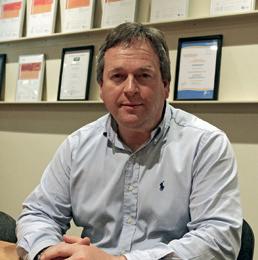
3 minute read
TECHNICAL FOCUS
from FC&A April 21

Advertisement
In this article, Sean Ballard, Managing Director of Sunray Doors, unearths the dos and don’ts of timber fire door specification for high-rise buildings. Speaking on behalf of Sunray’s Timber Fire Door division, he briefly runs through the essential elements to consider for optimum specification and installation, and outlines key points you should address to ensure high performance and compliance.
SEAN BALLARD

SUNRAY DOORS IS THE MANAGING DIRECTOR OF SUNRAY DOORS
Sunray Doors’ Timber Fire Door division manufactures and installs its range of timber fire doors and dual fire and security doors to a detailed methodology accredited by BM TRADA and Certifire
There are several specification and installation dos and don’ts to consider when it comes to new or existing highrise buildings. Here, I look at a few critical points you must think about when opting for timber fire doors for a high-rise project:
The dos
1. Appoint a competent and qualified Fire Door Inspection Scheme (FDIS) surveyor in the first instance to understand and formally report the level of existing compliance or non-compliance issues 2. Identify the key areas which are critical to providing passive fire protection. For example, in residential high-rise applications, these will include residents’ front doors, as well as all subsequent internal doors within apartments. 3. Identify public or communal areas of access, such as stairwells, entrance and lift lobbies, bin stores, underground parking access and any other points within the complex that could require a level of passive fire protection 4. Ensure the substructure around the fire door provides fire integrity, i.e. is it a real fire stop or fire break? Undertake a core sample if in doubt. 5. Ensure the correct level of fire door rating is appropriate for the application, i.e. using the minimum rating of FD30 may not be adequate in a high-rise building. Therefore, an upgrade may be required in the form of FD120. Also, make sure all internal doors provide an equal rating. 6. Consider door security as well as fire integrity. Sunray offers a combined SR- and FD-rated product. 7. The installation of fire doors must be undertaken in accordance with the manufacturer – or, ideally, installed by the manufacturer 8. Make sure the product specified conforms to accredited ratings such as BM TRADA and request proof from the manufacturer. This should also include the locking and hardware, vision panels and any additions to the door. 9. Request samples for evaluation and assurance of quality 10. Ascertain the product’s origin of manufacture.
The don’ts
1. Do not believe the performance marketed by any given manufacturer until you have the certification to back it up 2. Never compromise safety and product performance over budget
Key questions
1. Does the product meet UK Building Regulations for your specific application? 2. Are the installers competent, trained and certified in such products? 3. Post-specification and -installation, what is the warranty or lifespan of the product and its components? 4. Is there a service and maintenance schedule to ensure warranty validation?
POLYPIPE ADVANTAGE
MORE THAN FABRICATION

Polypipe Advantage is more than fabrication. But what do we mean by more?
From quotation to final delivery, you’re in control. With access to our team of specialists, full details on scheduling and logistics, detailed information and visual designs – all at your fingertips.
Fabricated water supply systems and drainage stack solutions arrive on-site, fully configured and ready to install. Whilst a dedicated project manager and technical team cover every detail to ensure that it fits perfectly; first time, every time.
What’s more, using the Polypipe Advantage Service gives you more time savings, more cost-effective installations and makes a complex project, simple. What more could you possibly need?










